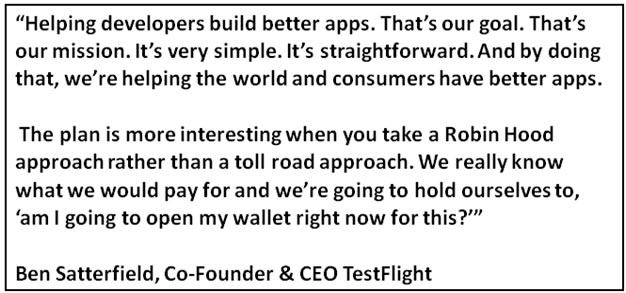
Messenger: Benjamin Satterfield, Co-Founder & CEO TestFlight, Founder Rootdown and Twiddla.
Value Prop Twitter Style: TestFlight helps developers build better apps.
You can watch the videos below or on YouTube here: PART I and PART II:
What follows is a summary which paraphrases Ben’s responses. For his exact quotes, watch the videos.
If you haven't already subscribed yet, subscribe now for
free weekly Infochachkie articles!

6) Ben, why does the app world need TestFlight?
"The world has told us they needed TestFlight. We developed it for ourselves. We had no idea we were making basically Excedrin and then giving it out to people. TestFlight does simple, elegant, over the air distribution of apps that are in development and haven’t been made available in the App Store yet. It is a really painless, fresh way to do that."
5) How does one go from earning a Masters in Traditional Chinese Medicine to Founding an Internet startup?
"I was excited by what I thought was going to be the future of mobile, back in Palm Pilot days. I was excited about information; I dropped out of school to do my first startup, RootDown. I was able to take a bunch of different passions and interests and unite them for one goal and I was hooked. Startups are about constant learning and I didn’t want to be the student of just one subject anymore.
I want to dedicate my life to learning, problem solving about not knowing what tomorrow is and being part of that change. (Studying Chinese Medicine in graduate school) allowed me to see intersection points to take different ideas and combine them. I think this was a big genesis of how TestFight began.
One thing you are taught in grad school for traditional Chinese Medicine is pattern diagnoses. In the development world, it is always about patterns. Having that observation skill, at least from a management level, has been helpful in doing multiple startups."
4) On your site’s front door, you thank Apple for ‘building the tools to make magic possible.’ You clearly have a great rapport with them, but with love comes the risk of rejection. What steps have you taken to be true to your Apple relationship, while mitigating the company’s overall risks?
"A little bit of a disclaimer, saying, ‘Hey Apple, we know we are doing stuff seemingly in the gray area, but we love you.’ They have given us all the tools … (which) enabled TestFlight to be what it is. It is an acknowledgement that we didn’t create all of this on our own.
We are not breaking any rules. We’re not even bending any rules. We are in a very different game as entrepreneurs. Whether you are doing apps on Facebook or apps on Android or apps on iOS, you are playing by someone else’s rules and you have to consider that they can come and turn you off. We are not trying to break rules…we want to provide a service that meets a need."
3) Given the less restrictive curation process within the Android marketplace, will TestFlight’s value proposition ever be applicable to Android app developers? If so, how will it manifest itself?
"Officially, we haven’t announced support for Android apps. We are not against it, but we feel that before we were to go that route we have to do an evaluation of what is most important to Android developers and what their unique pain points are. Over the air distribution is not sexy to them.
Even in its basic form, TestFlight is still valuable (to Android developers). You can manage teams. You can see if they opened the email. You can see if they installed the app. We recently announced our SDK for iOS. I think going that route (SDKs for Android) could be more interesting.
The real pain point with Android is fragmentation and testing. TestFlight is in that world. We have to add the ‘wow factor’ to Android and I believe that will come from giving insight… and showing causality."
2) You have previously indicated that TestFlight, in its current form, is just the "nose of the plane." Without unveiling the entire aircraft’s entire design, what should we expect to see as more and more of the plane leaves the hangar?
"Helping developers build better apps. That’s our goal. That’s our mission. It’s very simple. It’s straightforward. And by doing that, we’re helping the world and consumers have better apps.
We have identified four tent poles. (1) If you want to build a better app, you have to debug. TestFlight helps you manage the beta testing process. (2) Are you listening to users? Are you getting the pulse of what people want? (3) Watching. Often it is more important to watch what people are doing than just listening to what they are requesting. (4) You have all this information. TestFlight will offer you insight into what to do with that information (and allow you to) …iterate with a purpose. We want to address each one of these points in the most elegant way we can."
1) TestFlight allows iOS app developers to drag their IPA onto your front door and use your solution. This is about the lowest barrier to use I have seen online for a SaaS solution – no registration, no trials, just straight usage. In addition to your free solution, you also offer an enterprise edition. What are the primary benefits of the enterprise features and what are the characteristics of the ideal customer of the more robust solution?
"The plan is more interesting when you take a Robin Hood approach rather than a toll road approach. We haven’t officially announced what our enterprise service is.
Pretty much anyone doing anything significant in mobile, we’re really proud to say, most of them are using TestFlight already. They are expecting to have security, can they put it on their own servers? Ultimately, it comes down to, ‘I need to know you guys are going to pick up the phone.’ We really know what we would pay for and we’re going to hold ourselves to, ‘am I going to open my wallet right now for this?’ Larger companies don’t have a problem paying for things that meet their needs.
It’s not interesting and it’s not the best use of our time. I would rather have a couple large contracts floating hundreds of people rather than nickel and diming everyone.
Having something of value and putting a price tag on it…that’s not really innovative on a business level. I’m just looking to have a bigger impact here."




